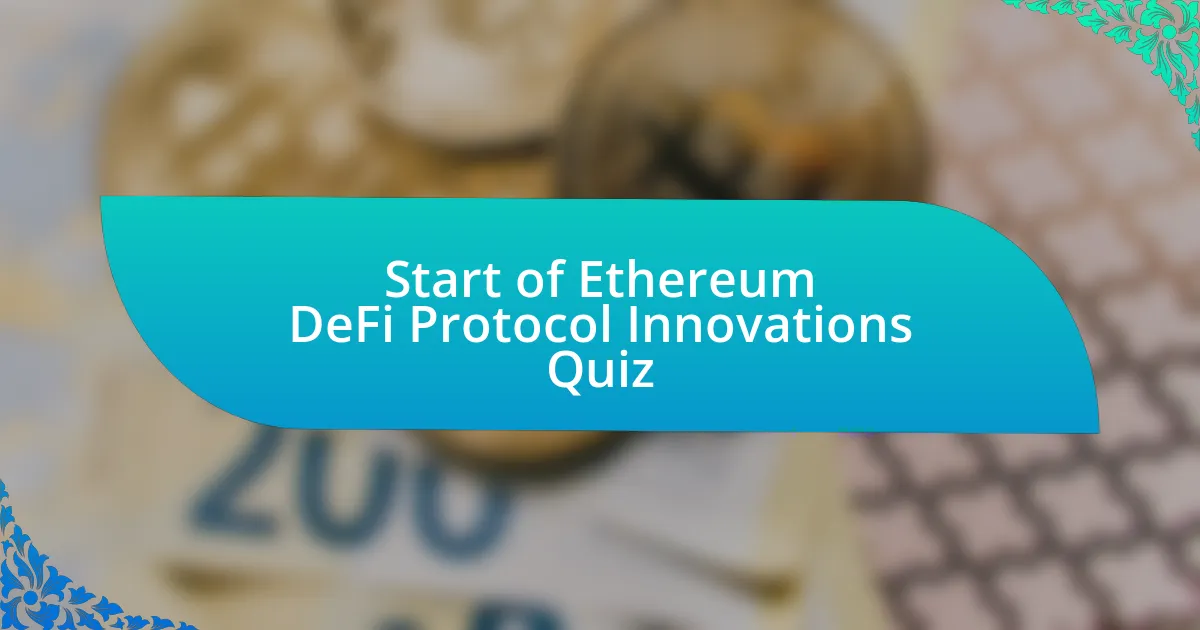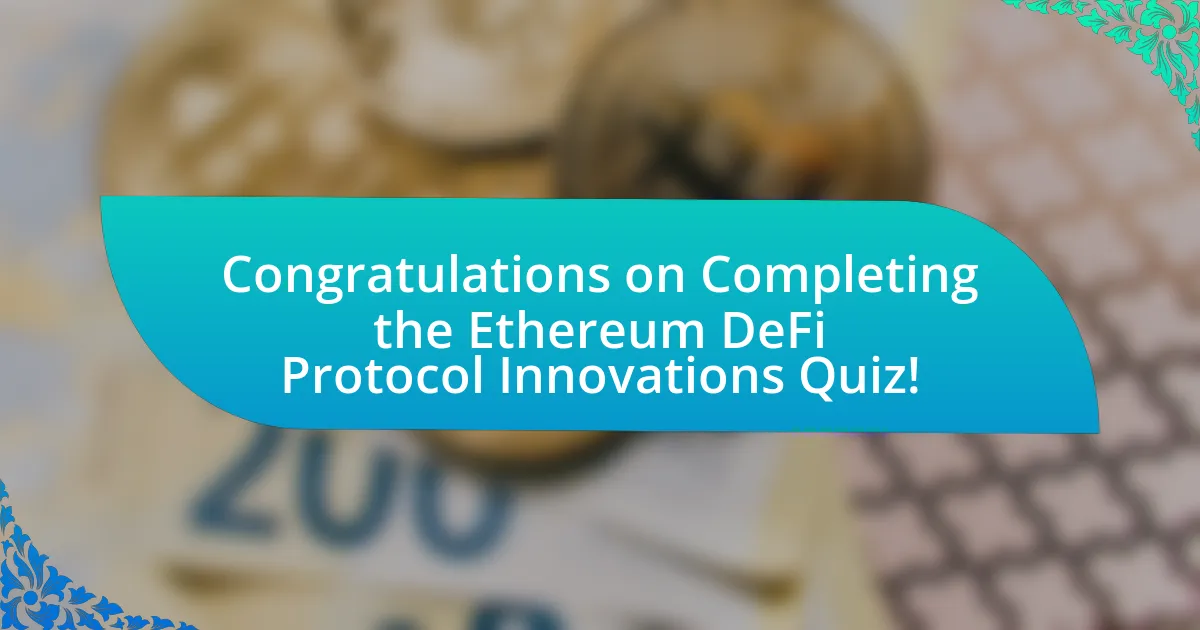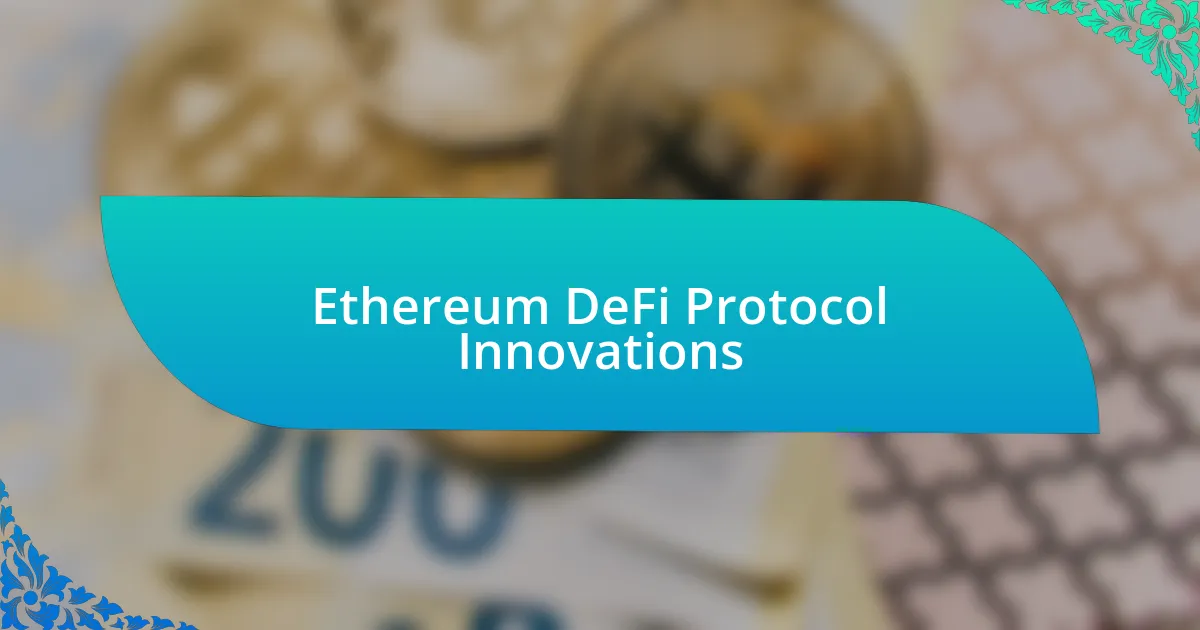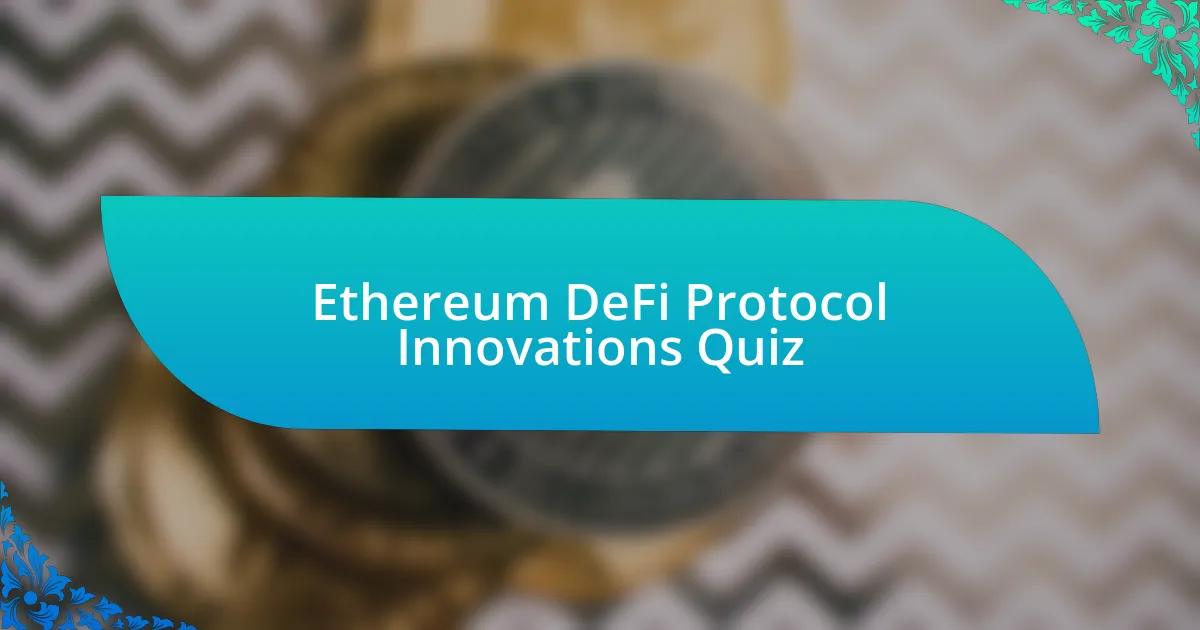
Start of Ethereum DeFi Protocol Innovations Quiz
1. What is the primary function of DeFi protocols on Ethereum?
- They serve primarily as marketplaces for trading physical goods.
- They focus on social networking features for users on Ethereum.
- They define the rules and mechanisms that govern financial interactions on the Ethereum blockchain.
- They provide a platform for centralized banking services on Ethereum.
2. How are DeFi protocols on Ethereum typically implemented?
- They are implemented through manual transaction recording and bookkeeping.
- They rely on centralized servers to process all transactions.
- They are based on smart contracts, which are autonomous programs that execute pre-established agreements without human intervention.
- They utilize traditional financial institutions for approval and execution.
3. What is the purpose of Uniswap in the Ethereum DeFi ecosystem?
- It functions as a central bank for issuing new cryptocurrencies.
- It provides a lending service for ETH holders to earn interest on their assets.
- It is a decentralized exchange protocol that allows users to swap ETH and ERC-20 tokens without the need for an intermediary.
- It is a payment system for transferring stablecoins between users.
4. What is the role of DAI in the Ethereum DeFi ecosystem?
- It is a governance token for managing DeFi protocols on the blockchain.
- It is a protocol that generates a decentralized stablecoin, whose value is pegged to the US dollar.
- It is a lending platform that offers high-interest loans to users.
- It is a reward system for providing liquidity to decentralized exchanges.
5. How do DeFi protocols ensure transparency in transactions?
- Transactions are hidden and can only be accessed by the developers of the protocol.
- Every transaction and every smart contract are recorded on the blockchain and can be verified by anyone.
- Only approved users can view transaction details on a centralized server.
- All transaction details are stored in private databases with restricted access.
6. What security measures do DeFi protocols employ?
- Protocols rely on physical hardware security measures for protection.
- Security is provided through traditional financial institution oversight.
- Protocols are secured by cryptography and smart contracts are immutable once deployed on the blockchain.
- Security is based on centralized server management and user authentication systems.
7. What is the interest rate mechanism in Compound?
- It is set by the average interest rates of banks globally.
- It is automatically adjusted based on supply and demand.
- It is determined by a central authority to standardize rates.
- It is fixed at a simple interest rate of 5%.
8. How do DeFi protocols reduce fees?
- By eliminating intermediaries, such as banks and brokers, users can save on transaction fees, service fees, and other costs associated with traditional financial services.
- By implementing higher service fees for faster processing times.
- By requiring users to pay network fees for every transaction made.
- By increasing transaction volume, which often leads to lower individual fees.
9. What is composability in the context of DeFi?
- It refers to the ability of DeFi protocols to fit together like “building blocks” to create new products and services.
- It involves the use of blockchain technology for identity verification.
- It describes the process of decentralizing traditional financial institutions.
- It signifies the reduction of transaction fees in financial systems.
10. What is the significance of interconnectivity in the DeFi ecosystem?
- Interconnectivity leads to increased transaction fees, making services more expensive.
- It ensures that all transactions are anonymous and untraceable.
- Interconnectivity simplifies the user interface for all decentralized applications.
- Different protocols and services can interact with each other, creating an integrated network of financial services.
11. What is the primary advantage of using smart contracts in DeFi?
- Smart contracts offer a conflict-free approach to deals, agreements, and disputes by automating processes transparently.
- Smart contracts require manual intervention to resolve disputes and agreements.
- Smart contracts limit user participation in transactions and agreements.
- Smart contracts rely on intermediaries to facilitate agreements effectively.
12. Where are transactions recorded in the Ethereum network?
- Spreadsheet
- Blockchain
- Database
- Server
13. What are the three types of Ethereum networks?
- Public, private, and test networks.
- Layer 1, layer 2, and sidechains.
- Direct, indirect, and relational networks.
- Centralized, decentralized, and hybrid networks.
14. How does mining work in Ethereum?
- Miners validate transactions through physical meetings, where they discuss and approve changes to the blockchain.
- Miners create new Ethereum blocks by solving complex mathematical puzzles using paper and pens.
- Miners push transaction data through a centralized server to process and confirm them before adding to the blockchain.
- Miners participate in the network using tools like Geth CLI to help add transactions to blocks and earn newly minted tokens as block rewards.
15. What is the purpose of MetaMask in the Ethereum ecosystem?
- It is a platform for creating and managing smart contracts.
- It functions as a cryptocurrency mining application.
- It serves as a decentralized exchange for trading tokens.
- It is a popular browser-based Ethereum wallet used to interact with dApps on the Ethereum network.
16. Which programming language is primarily used to write smart contracts and dApps?
- Ruby
- JavaScript
- Solidity
- Python
17. What is the role of oracles in DeFi protocols?
- Oracles create new cryptocurrencies to enhance DeFi protocols.
- Oracles facilitate peer-to-peer lending in DeFi markets.
- Oracles help fetch external data for smart contracts to ensure they have the necessary information to execute their functions.
- Oracles store user data for DeFi applications securely.
18. What is the significance of stablecoins in DeFi?
- Stablecoins are primarily used for long-term investments with high returns.
- Stablecoins function as a centralized currency controlled by banks.
- Stablecoins provide price stability, allowing users to trade assets without the volatility associated with other cryptocurrencies.
- Stablecoins only serve as a means to increase speculation in the market.
19. How do DeFi protocols offer yield farming and staking opportunities?
- Users gain bonuses by trading frequently on centralized exchanges without restrictions.
- Users will earn fixed rates by depositing cash in traditional banking institutions.
- Users can invest in traditional stocks and receive interest from their savings accounts.
- Users can earn rewards by locking up their assets in a decentralized protocol, typically paid out in the platform’s native tokens.
20. What is the purpose of governance tokens in DeFi protocols?
- Governance tokens enable holders to vote on crucial matters, such as protocol updates, fee adjustments, and other significant concerns.
- Governance tokens serve as collateral for loans and borrowing within the protocol.
- Governance tokens are primarily used for trading assets on decentralized exchanges.
- Governance tokens allow users to earn passive income through staking rewards and interest.
21. How do DeFi protocols reduce costs and increase efficiency?
- By imposing higher fees on transactions to support decentralized maintenance.
- By complicating processes in order to increase user engagement and network activity.
- By increasing the number of intermediaries to enhance transaction speed and security.
- By removing intermediaries, such as banks and brokers, and streamlining financial processes through automation.
22. What is the impact of composability on DeFi innovation?
- Composability allows different protocols and services to interact, creating new financial products and services by combining existing ones.
- Composability restricts interaction, limiting the creation of new financial products and services.
- Composability makes DeFi protocols operate independently without any connections to each other.
- Composability enhances the complexity of using DeFi products, slowing down innovation.
23. How do DeFi protocols handle lending and borrowing?
- Users can provide their assets as collateral to earn interest or borrow other assets based on their collateral, all managed by smart contracts.
- Users are required to use traditional banks to handle transactions.
- Users lend and borrow only through centralized exchanges.
- Users trade assets directly without any collateral requirements.
24. What is the role of the Ethereum Virtual Machine (EVM) in executing smart contracts?
- The EVM is a consensus mechanism that validates transactions through mining.
- The EVM is a blockchain explorer that tracks transactions on Ethereum networks.
- The EVM is a virtual computer that executes smart contracts, ensuring the automation of agreements within DeFi protocols.
- The EVM is an interface for developing mobile applications on Ethereum.
25. How do DeFi protocols ensure the security and reliability of the network?
- User verification through email ensures the security and reliability of the network by confirming identities.
- Regular software updates maintain the security and reliability of the network by fixing bugs and vulnerabilities.
- Consensus mechanisms like Proof-of-Stake ensure the security and reliability of the network by validating transactions and adding them to the blockchain.
- Centralized servers manage the security and reliability of the network by controlling transactions and data.
26. What is the purpose of on-chain options and derivatives in DeFi?
- They offer a platform for centralized exchanges to maintain control over trading.
- They create new cryptocurrencies on the Ethereum blockchain to benefit users.
- They are designed to replace traditional banking systems entirely with no intermediaries.
- They bring options contracts onto the blockchain, enhancing transparency and potentially improving security by eliminating the need for centralized exchanges.
27. How do DeFi protocols integrate real-world assets into the ecosystem?
- Future projects will explore ways to tokenize real-world assets on the blockchain, enabling fractional ownership and easier access to financial products through DeFi applications.
- They simply replicate the operations of traditional financial institutions, making no significant changes to asset management.
- They utilize centralized databases to manage real-world assets, ensuring security through traditional methods.
- They require physical verification of assets before integration into the DeFi ecosystem, which slows down the process.
28. What is the significance of user experience in DeFi innovation?
- User experience is only important for centralized finance, not decentralized finance.
- User experience primarily affects how miners validate transactions in DeFi.
- Future projects will focus on streamlining user interfaces and functionalities to make DeFi features like borrowing and lending crypto more accessible.
- User experience is irrelevant to the development of smart contracts in DeFi protocols.
29. How do DeFi protocols prioritize security?
- Protocols depend solely on centralized authorities to manage security issues.
- DeFi platforms prioritize speed over security, often disregarding audits.
- Future projects will implement advanced security protocols, smart contract audits, and bug bounty programs to make DeFi platforms less susceptible to exploits.
- They rely on user feedback to improve their interface without any technical safeguards.
30. What is the role of governance tokens in shaping the growth and trajectory of DeFi protocols?
- Governance tokens serve as rewards for users participating in liquidity mining activities.
- Governance tokens act as a form of collateral for borrowing assets in DeFi ecosystems.
- Governance tokens are primarily used for trading on centralized exchanges for profit.
- Governance tokens enable holders to vote on crucial matters, such as protocol updates, fee adjustments, and other significant concerns.

Congratulations on Completing the Ethereum DeFi Protocol Innovations Quiz!
You’ve just completed a journey into the innovative world of Ethereum DeFi protocols. We hope you found the quiz enjoyable and enlightening. Engaging with the questions has likely expanded your understanding of how decentralized finance is reshaping the financial landscape. Whether you learned about key protocols, mechanisms, or the underlying technology, every bit of knowledge helps in grasping this complex subject.
Through this quiz, you may have discovered new concepts like liquidity pools, yield farming, and composability. These topics are crucial in recognizing how DeFi platforms operate and interact. Moreover, understanding the innovations within Ethereum’s ecosystem is essential for anyone looking to navigate the future of finance effectively. It’s exciting to see how these protocols empower users with new financial opportunities.
If you’re eager to deepen your knowledge further, we invite you to explore the next section on this page. It contains detailed information on Ethereum DeFi Protocol Innovations. This additional content will provide you with valuable insights and help solidify your understanding. Dive in and continue your exploration of this fascinating area!

Ethereum DeFi Protocol Innovations
Understanding Ethereum and Its Role in DeFi Innovations
Ethereum is a decentralized blockchain platform that supports smart contracts. These contracts are self-executing agreements with the terms directly written in code. DeFi, or decentralized finance, leverages Ethereum’s capabilities to create open financial systems without intermediaries. Innovations in this space include protocols for lending, borrowing, and trading that operate entirely on the blockchain. This allows users to interact directly and take full control of their assets, leading to increased accessibility and transparency in finance.
Key Protocols Driving DeFi Innovations on Ethereum
Several key protocols drive DeFi innovation on Ethereum. Notable examples include Uniswap, Aave, and Compound. Uniswap facilitates automated token exchanges through liquidity pools instead of traditional order books. Aave offers innovative lending options, enabling users to lend and borrow assets without intermediaries. Compound allows users to earn interest on their assets by supplying them to others, creating a decentralized money market. These protocols exemplify how Ethereum enables new financial instruments by using smart contracts to automate transactional processes.
The Impact of Layer 2 Solutions on Ethereum DeFi
Layer 2 solutions significantly enhance Ethereum’s capabilities for DeFi applications. These solutions, such as Optimism and Arbitrum, improve transaction speeds and reduce costs by processing transactions off the main blockchain. This scalability addresses Ethereum’s congestion issues, making DeFi applications more efficient and user-friendly. As a result, users experience faster transactions and lower fees, which are crucial for mass adoption of DeFi platforms.
Innovations in Security Protocols for Ethereum DeFi
Security is paramount in the DeFi space due to the high stakes involved. Innovations focus on improving protocol security through auditing, insurance, and formal verification. Auditing services analyze smart contracts for vulnerabilities before launch, while decentralized insurance protocols protect users against unexpected losses. Moreover, formal verification mathematically proves the correctness of smart contracts, ensuring they behave as intended. These measures build user trust and enhance the overall safety of DeFi platforms on Ethereum.
Future Trends in Ethereum DeFi Protocol Developments
Future trends in Ethereum DeFi protocols point toward increased interoperability and integration with traditional finance. Innovations like cross-chain protocols enable seamless interaction between different blockchain networks, enhancing liquidity and user experience. Additionally, the rise of synthetic assets and decentralized stablecoins is expected to further diversify financial instruments in DeFi. These trends indicate a growing convergence between decentralized and traditional financial systems, pushing the boundaries of what DeFi can achieve.
What are Ethereum DeFi protocol innovations?
Ethereum DeFi protocol innovations refer to new developments and improvements within decentralized finance applications built on the Ethereum blockchain. These innovations often enhance financial products, like lending, borrowing, and trading, by leveraging smart contracts. Key examples include automated market makers (AMMs) such as Uniswap, which utilize liquidity pools to facilitate transactions without the need for order books. Additionally, yield farming techniques allow users to earn rewards by providing liquidity, thus incentivizing participation in the ecosystem.
How do Ethereum DeFi protocols function?
Ethereum DeFi protocols function through smart contracts, which are self-executing contracts with terms directly written into code. Users interact with these protocols via decentralized applications (dApps) that allow them to perform various financial operations without intermediaries. Transactions are facilitated through blockchain technology, ensuring transparency and security. For example, users can lend assets on Aave and earn interest, while borrowers can access these funds without undergoing traditional credit checks.
Where can Ethereum DeFi protocols be accessed?
Ethereum DeFi protocols can be accessed on various decentralized platforms and dApps, primarily through web interfaces or mobile applications. Common platforms include Aave, Compound, and MakerDAO, which allow users to lend, borrow, or mint stablecoins. These protocols are typically available through web3 wallets like MetaMask, allowing users to connect directly to the Ethereum network and interact with DeFi services securely.
When did Ethereum DeFi innovations gain significant traction?
Ethereum DeFi innovations gained significant traction in 2020, often referred to as the “DeFi summer.” This period saw an explosive growth in user engagement and total value locked (TVL) in DeFi protocols, increasing from approximately $1 billion in early 2020 to over $10 billion by mid-2020. This surge highlighted Ethereum’s potential to transform traditional financial services through decentralized mechanisms.
Who are the main contributors to Ethereum DeFi protocol innovations?
The main contributors to Ethereum DeFi protocol innovations include a range of developers and organizations within the blockchain community. Prominent projects are often led by teams like the Uniswap Protocol, Aave, and Compound Labs, which have attracted significant venture capital funding and community support. Additionally, open-source contributors and independent developers regularly enhance protocols, ensuring continuous innovation in the ecosystem.

